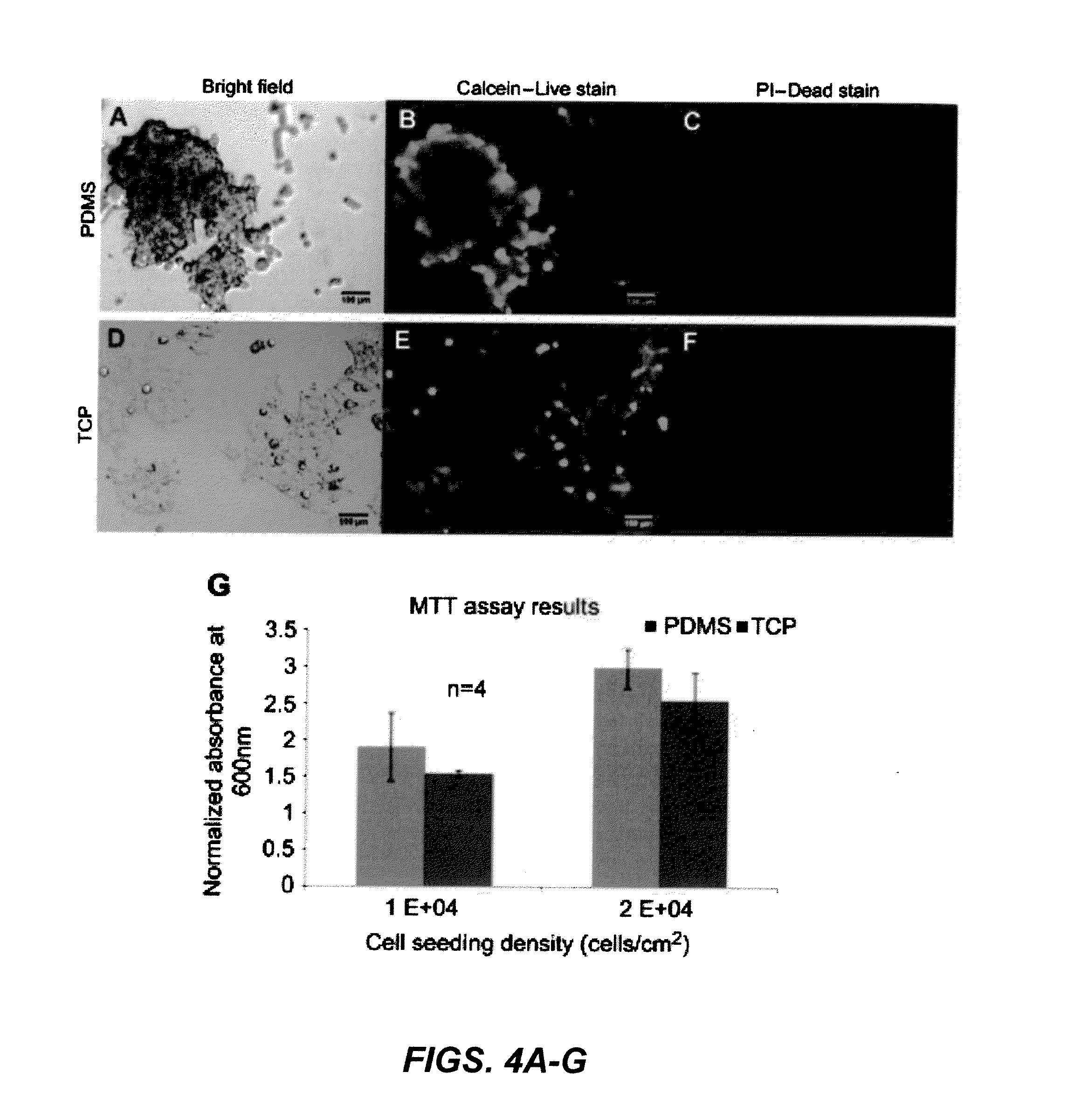Method of enriching stem and/or progenitor cells
a progenitor cell and stem cell technology, applied in the field of assays, can solve the problems of not observing enhanced self-renewal or tumor initiating capacity, time-consuming process, complex methods, etc., and achieve the effect of reducing concerns about clone aggregation
- Summary
- Abstract
- Description
- Claims
- Application Information
AI Technical Summary
Benefits of technology
Problems solved by technology
Method used
Image
Examples
example 1
Morphology of WM115 Cell Line on Planar PDMS and TCP
[0093]WM115 cells were seeded at a density of 2×104 cells / cm2 on TCP and planar PDMS and cultured as described in the preceding Materials and Methods. Results indicated that WM115 cells propagate as a monolayer on TCP (FIG. 3A); however, on planar hydrophobic PDMS they tend to propagate with a non-adherent 3D cluster morphology (FIG. 3B). Plasma treated TCP is hydrophilic, which favors cell adhesion and spreading, whereas PDMS is a hydrophobic polymer that hinders cell adhesion causing cells to adopt 3D cluster morphology.
example 2
Viability of WM115 Cell Line on TCP and Planar PDMS
[0094]Cell viability was tested using an assay with calcein-AM and propidium iodide for live and dead stain, respectively. Calcein-AM is membrane permeable and is cleaved by active esterases in live cells which produce a fluorescence signal. Propidium iodide is cell membrane impermeable, however, dead cells that have degraded cell membranes allow the stain to enter where it intercalates DNA. The stains were applied to the cells after 4 days of incubation on planar PDMS and TCP (FIGS. 4A, 4D) as described in Section 2.4 and results showed that most cells were viable based on fluorescence visualization. Cells propagating as 3D clusters and monolayer on TCP stain positive for the live stain (FIGS. 4B, 4E) and there is very little staining for dead stain (FIGS. 4C, 4F). This suggested that there was sufficient nutrient uptake by cells propagating as 3D clusters on planar PDMS.
[0095]MTT assay results show the effect of the PDMS substrate...
example 3
Effect of Sub-Culturing WM115 Cell Line from Planar PDMS to TCP
[0096]WM115 cells propagating as 3D clusters on planar PDMS were non-adherent to the underlying substrate and pipetting the media ensured the removal of cells from the well. When the cells cultured on planar PDMS were harvested, dissociated and plated (seeding density=1×104 cells / cm2) as individual cells on TCP (FIG. 5A), cells with two distinct morphology emerged on TCP by the end of day 4 (FIG. 5B). WM115 cells exhibited a unique “fried egg” morphology comprised of cells that formed tightly packed non-adherent spheroids (NA / S) in the center surrounded by cells that propagated as an adherent monolayer (AM).
PUM
| Property | Measurement | Unit |
|---|---|---|
| elastic modulus | aaaaa | aaaaa |
| elastic modulus | aaaaa | aaaaa |
| elastic modulus | aaaaa | aaaaa |
Abstract
Description
Claims
Application Information
 Login to View More
Login to View More - R&D
- Intellectual Property
- Life Sciences
- Materials
- Tech Scout
- Unparalleled Data Quality
- Higher Quality Content
- 60% Fewer Hallucinations
Browse by: Latest US Patents, China's latest patents, Technical Efficacy Thesaurus, Application Domain, Technology Topic, Popular Technical Reports.
© 2025 PatSnap. All rights reserved.Legal|Privacy policy|Modern Slavery Act Transparency Statement|Sitemap|About US| Contact US: help@patsnap.com



